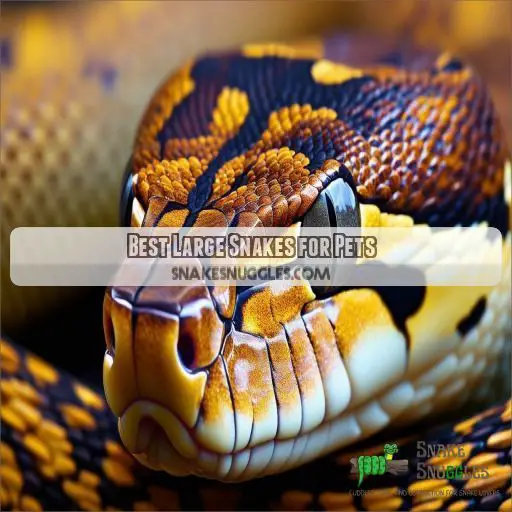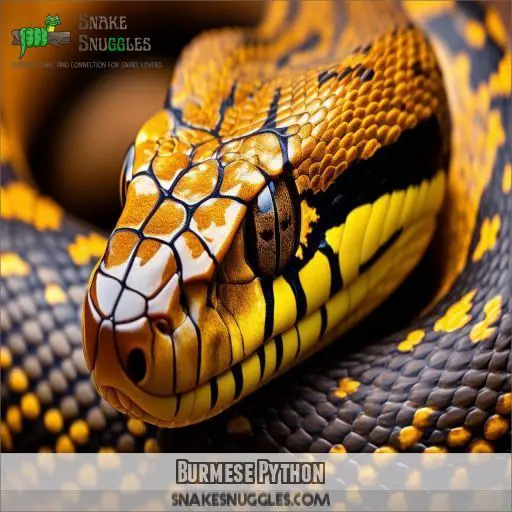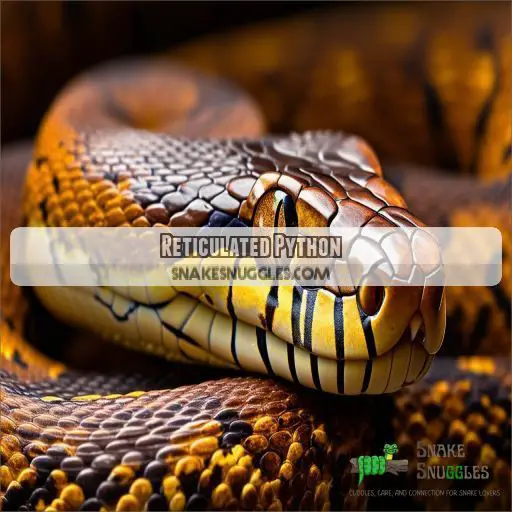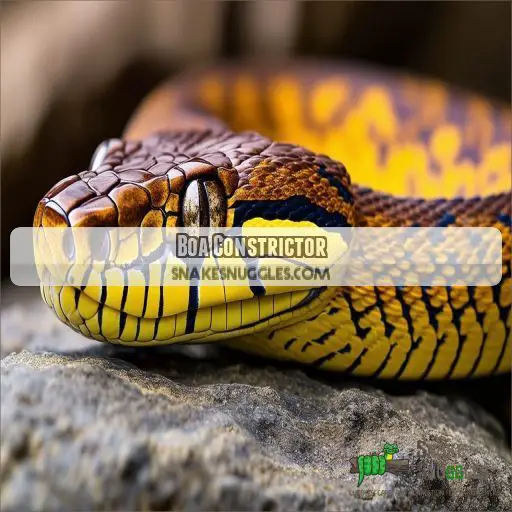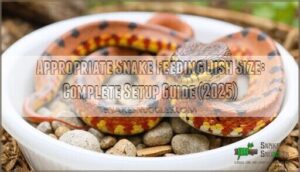This site is supported by our readers. We may earn a commission, at no cost to you, if you purchase through links.
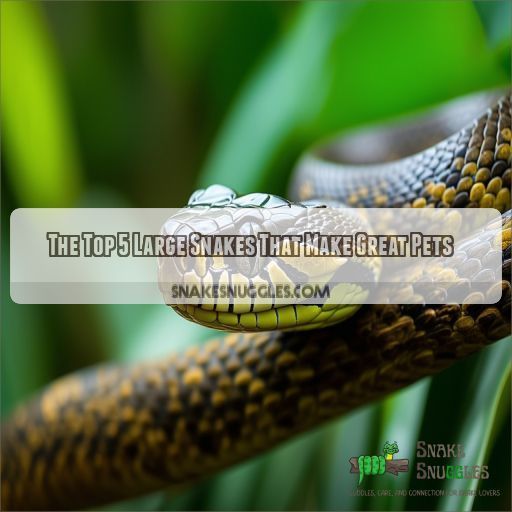 Snakes are fascinating creatures, and if you’re interested in owning one, you’re in luck!
Snakes are fascinating creatures, and if you’re interested in owning one, you’re in luck!
Today, we’ll be looking at the top five large snakes that can make great pets.
From the Burmese Python to the African Rock Python, get ready to learn about these amazing animals and why they might be the perfect fit for your home.
Table Of Contents
Key Takeaways
- Space is key: Your pet snake needs room to slither and stretch. A cozy enclosure for a python might be 4x2x4, but a king cobra? They need a palace with a 16×16 floor plan.
- It’s dinner time: These scaly friends are carnivores with a taste for small mammals, birds, and the occasional reptile. No salads here!
- Handle with care: Some snakes are chill, while others are feisty. Regular handling can help tame a snake, but always do your research to keep yourself safe and your snake happy.
- Long live the snake: With proper care, some snakes can live for decades. Ball pythons, for example, can be your companion for 20-30 years.
What Are the Best Large Snakes for Pets?
Choosing a large snake as a pet is a big responsibility, and you need to do your research first. Some of the best large snake species for pets include the Burmese Python, Reticulated Python, Boa Constrictor, and African Rock Python. Each species has its own unique characteristics, so you need to understand their specific requirements and temperaments before making a decision.
Stay tuned to learn more about these fascinating creatures and how to provide them with the best care.
Best Large Snakes for Pets
Choosing a large snake as a pet involves many things to think about.
First off, it’s super important to focus on the snake’s care and well-being.
These amazing creatures need roomy enclosures that let them act naturally, like climbing and exploring.
Their eating habits are another big deal, since they usually eat whole prey like rodents.
You need to find these ethically and make sure their diet is balanced.
It’s also key to understand their personalities.
Some snakes are more chill and easy to handle, while others might be more defensive or aggressive.
Doing your research is really important to keep the snake comfy and you safe.
With the right knowledge and dedication, owning a large snake can be a rewarding experience, offering a special connection with these fascinating creatures.
Burmese Python
Burmese pythons are a popular choice for large pet snakes due to their impressive size and temperament.
They require a spacious enclosure to accommodate their adult size, with proper temperature gradients and humidity levels maintained.
As carnivores, their diet consists of small to medium-sized mammals, birds, and occasionally reptiles.
In captivity, it’s important to offer them a varied diet to meet their nutritional needs.
Young Burmese pythons can be fed appropriately sized rodents, while adults require larger prey items such as rabbits or small birds.
It’s recommended to avoid live prey, as it can stress the snake and pose risks.
Burmese pythons should always have access to fresh water, and while some individuals may tolerate handling, they’re generally not as docile as other pet snakes and should be handled with caution.
Reticulated Python
Reticulated pythons are giants, weighing over 200 lbs. They’re typically slow-moving, spending most of their day at rest or waiting for prey. These snakes are aggressive in the wild, but captive-bred specimens are calmer due to selective breeding. They require expert handling to become loyal companions.
Housing needs: Reticulated pythons require a large, custom enclosure, about two feet wide by three feet tall by eight feet long, or a small bedroom or walk-in closet. They should be housed individually. Proper heating, humidity, and enrichment are essential.
Feeding habits: It takes 2-4 months of consistent attempts to train a reticulated python to accept frozen-thawed prey.
Care tips: To calm your reticulated python, pet it before handling. Use tools like hooks and paper towels to avoid bites, and always have an experienced assistant present.
Boa Constrictor
Boa constrictors are a great choice for those seeking a large snake as a pet. They’re typically active and alert snakes with a docile temperament. While they might hiss or bite if they feel threatened, regular handling will help them become tame and comfortable around people.
These snakes are native to Central and South America and can grow to be quite large, so they’re best suited for experienced owners. Regarding feeding, boas only require quality mice or rats with no additional supplementation. Young boas should be fed one appropriately-sized rodent every seven to ten days, while adult boas can be fed every ten to fourteen days.
Housing boas separately is recommended unless you intend to breed them. Boa constrictors are heavy-bodied and muscular, with an average female weighing between 10-15 kg. This means they require a bit of strength to handle, and children should always be supervised when handling these snakes.
African Rock Python
African Rock Pythons are intelligent but have a nasty reputation, and can be aggressive and defensive when threatened. They’re best left to advanced herpetoculturists. They’ve similar housing requirements to reticulated pythons, and should be housed separately from other snakes.
African Rock Pythons can be aggressive and unpredictable. They’re known to lash out and bite when they feel threatened, and can also spray a nasty-smelling substance from their tails.
Captive-bred African Rock Pythons can be tamed with regular handling.
African Rock Pythons are carnivores and require a permanent food source. In the wild, they feed on large rodents, monkeys, warthogs, antelopes, vultures, fruit bats, monitor lizards, crocodiles, and more. In suburban areas, they hunt rats, poultry, dogs, and goats.
Frequently Asked Questions (FAQs)
How much space do large pet snakes need?
The space needed depends on the snake’s size. A snake should have enough room to fully stretch out. For example, a 4-5ft python needs a 3×2 floor space as a minimum, but a 4x2x4 space is better. A king cobra requires a huge 16×16 enclosure.
What colours do pet snakes come in?
Pet snakes come in a variety of colors, including olive, dark brown, gold, yellow, red, orange, and black. Some snakes, like the Colombian boa, have been bred in captivity to showcase a range of color morphs.
What should I feed my pet snake?
Snakes are carnivores, so they eat meat. Typically, snakes in captivity are fed mice or rats, which are nutritionally complete meals. Make sure the prey is approximately the same diameter as the snake. Feed young snakes twice a week and mature snakes once a week.
Do pet snakes live a long time?
Snakes can live a long time, with the lifespan depending on the species. Some snakes live for 5 years, while others can live for 30+ years. Ball pythons, for example, can live for 20-30 years.
What are some beginner-friendly large snakes?
If you’re looking for a large snake that’s beginner-friendly, you might want to check out a gopher snake. They’re one of North America’s largest species, reaching up to six feet in length, but they’re still a great option for first-time snake owners.
Conclusion
So, there you have it!
You’re now equipped with a reptilian roster of the top five large snakes that can make great pets.
From the Burmese Python to the African Rock Python, these scaly companions offer a unique and engaging presence in your home.
Happy herping!

